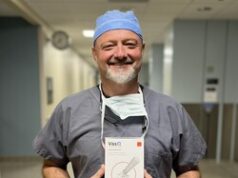 The results of a randomised controlled trial—the Shunt simulation study—show that a new patient-specific computation model accurately calculated postoperative access flow. As flow is related to maturation, the authors argue that this model may potentially improve arteriovenous fistula (AVF) maturation rates.
The results of a randomised controlled trial—the Shunt simulation study—show that a new patient-specific computation model accurately calculated postoperative access flow. As flow is related to maturation, the authors argue that this model may potentially improve arteriovenous fistula (AVF) maturation rates.
Authors Niek Zonnebeld (Maastricht University, Maastricht, The Netherlands) and colleagues— on behalf of the Shunt simulation study group— add that further investigation is needed to improve the predictive power of these simulations in order to render the computational model an adjunct to surgical planning.
Writing in the July edition of the European Journal of Vascular and Endovascular Surgery (EJVES), Zonnebeld et al detail that an AVF needs to mature before it becomes suitable to cannulate for haemodialysis treatment, and that maturation depends on postoperative flow increase.
The authors highlight that AVF maturation remains a permanent issue in vascular access surgery for haemodialysis treatment, with 20–40% of AVFs failing to mature. To address this, they developed a patient-specific computational model that predicts immediate postoperative flow, and hypothesised that providing information from this model for planning of fistula creation might reduce failure rates. Zonnebeld and colleagues conducted a multicentre, randomised controlled trial in nine Dutch hospitals, in which they recruited patients with renal failure who were referred for AVF creation. Using 1:1 randomisation, they assigned patients to the control or computer simulation group. Both groups underwent a work up, with physical and duplex ultrasonography (DUS) examination.
In the simulation group, the data from the DUS examination were used for model simulations, and—based on the immediate postoperative flow prediction—the ideal AVF configuration was recommended.
Zonnebeld et al detail that the primary endpoint was AVF maturation defined as an AVF flow ≥500ml/min and a vein diameter of ≥4mm six weeks postoperatively. The secondary endpoint was model performance (i.e. comparisons between measured and predicted flows, and (multivariable) regression analysis for maturation probability with accompanying area under the receiver operator characteristic curve.
A total of 236 patients were randomly assigned (116 in the control and 120 in the simulation group), of whom 205 (100 and 105, respectively) were analysed for the primary endpoint.
The authors report in EJVES that there was no difference in failure to mature rates between the groups (29% and 32%, respectively). Immediate postoperative flow prediction had an odds ratio [OR] of 1.15 (1.06– 1.26; p<0.001) per 100ml/ min for maturation, and the accompanying operator characteristic curve was 0.67 (0.59–0.75).
Zonnebeld and colleagues recognise that the study has several limitations, including the fact that the primary endpoint was not a clinical one; it does not give any information on the functionality/usability of the AVF. However, they stress that it is an objective measure, and when patients reach the criteria of ≥500ml/min and a vein diameter of 4mm, as defined in this study, there is a 95% likelihood that the AVF will become functional.
Furthermore, to assess the vascular access functionality, the included patients should have initiated dialysis treatment. However, it remains very difficult to predict which and when a predialysis patient will progress to dialysis dependency and start haemodialysis. In the latter group of patients clinical AVF functionality cannot be determined.
Despite these limitations, the authors highlight the generalisable nature of their results, due to the fact that most of the (pre-)haemodialysis patients in need of an AVF were eligible for inclusion, and that the study was designed in such a way that it could be implemented easily in daily practice. In addition, DUS protocols were standardised to comply with the model’s demands. Usually, Dutch hospitals have well-equipped vascular laboratories with trained technicians who routinely perform preoperative DUS examination for AVF surgery.
Zonnebeld et al write that the multicentre design of the present study is a “major strength”, as it shows that the model can be implemented in other clinics. In addition, they note that selection of dialysis facilities for the multicentre study ensured a representative sample of the Dutch dialysis population, comparable with other European populations and studies. Compared with North American studies, however, they recognise that there is a considerably lower percentage of blacks included.
The authors summarise that simulating patient-specific immediate postoperative flows is an “innovative approach” to improve AVF maturation. “Since AVF maturation does not depend on blood flow enhancement through the anastomosed vessels exclusively, the predictive power of a single model was found to be insufficient to support clinical decision-making,” they write.
Looking to the future, the Shunt simulation study group speculate that incorporating the flow predictions in a hybrid model, in which other relevant but non-physical parameters or factors can be incorporated, might be beneficial.













